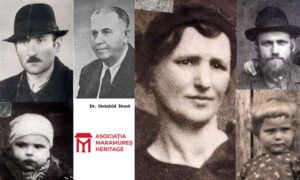Comunitatea evreiască din Bogdan Vodă (Cuhea), Maramureș
🇷🇴/🇭🇺/🏴
În documentele evreiești localitatea este pomenită sub denumirea de Kechnia. Primii evrei au sosit în Bogdan Vodă din localitatea Dragomirești la începutul secolului XVIII. În 1840 numărul evreilor era de 86 de persoane, iar în anul 1921 numărul acestora ajunsese la 477 de suflete.
Majoritatea evreilor din sat munceau ca zilieri pe la diferitele exploatări forestiere, plutași sau meseriași.
Cimitirul a fost înființat la final de secol XVIII, iar prima sinagogă a fost construită la mijlocul secolului XIX. Comunitatea de aici nu era de sine stătătoare, a fost arondată celei din Sighet, iar mai târziu celei din Dragomirești.
La începutul anilo 1900 în Bogdan Vodă (Cuhea) s-a mutat cunoscutul rabin hasid Pinha Sapira. Toți evreii din localitatea aveau ca limba maternă idiș.
La mijlocul lunii aprilir din anul 1944 evreii din Bogdan Vodă (Cuhea), au fost duși de către jandamrii fasciști maghiari în ghetoul din Dragomirești, iar în mai au fost deportați din gara Vișeu de Sus în Auschwitz.
Aproape toți evreii din localitate au fost uciși aici de către naziști. Puținii supraviețuitori care s-au întors acasă au emigrat la finalul anilor 40. Doi evrei originari din localitate au murit în războiul de independență al statului Israle în anul 1948.
Azi nu mai trăiesc evrei în comuna Bogdan Vodă (Cuhea).
A máramarosi Bogdan Voda (Izakonyha) zsidó közössége
A zsidó okiratokban a helység Kechnia néven szerepel. Az első zsidók Dragomérfalváról érkeztek Izakonyhára a 18. század elején. 1840-ben a zsidók száma 86 fő volt, 1921-ben pedig elérte a 477 lelket.
A faluban élő zsidók többsége napszámosként dolgozott a különféle erdészeti kitermeléseknél, szarufán vagy iparosként is előfordulnak az okiratokban.
A temető a 18. század végén, az első zsinagóga pedig a 19. század közepén épült. Az itteni közösség nem volt önálló, a szigetihez, majd a dragomérfalvihoz csatolták.
Az 1900-as évek elején az ismert haszid rabbi, Pinha Sapira Izakonyhára költözött. A helységben élő összes zsidónak jiddis volt az anyanyelve.
1944. április közepén Izakonzha zsidóit a magyar fasiszta csendőrök a Dragomérfalvi gettóba hurcolták, májusban pedig Felsővisó vasútállomásról Auschwitzba deportálták őket.
Szinte az összes helyi zsidót itt ölték meg a nácik. Az a néhány túlélő, aki hazatért, az 1940-es évek végén emigrált. 1948-ban Izrael állam szabadságharcában halt meg két helységbeli zsidó.
Ma már nem élnek zsidók Izakonyhán.
The Jewish community of Bogdan Voda (Cuhea), Maramure county, Romania
In Jewish documents the locality is mentioned under the name of Kechnia. The first Jews arrived in Bogdan Vodă from Dragomirești at the beginning of the 18th century. In 1840 the number of Jews was 86 people, and in 1921 their number had reached 477 souls.
Most of the Jews in the village worked as day laborers at the various forestry operations, rafters or craftsmen.
The cemetery was established at the end of the 18th century and the first synagogue was built in the middle of the 19th century. The community here was not independent, it was annexed to that of Sighet, and later to that of Dragomirești.
At the beginning of the 1900s, the well-known Hasidic rabbi Pinha Sapira moved to Bogdan Vodă (Cuhea). All the Jews in the locality had Yiddish as their mother tongue.
In mid-April of 1944, the Jews of Bogdan Vodă (Cuhea) were taken by the Hungarian fascist gendarmes to the Dragomirești ghetto and in May they were deported from Vișeu de Sus train station to Auschwitz.
Almost all the local Jews were killed here by the Nazis. The few survivors who returned home emigrated at the end of the 1940s. Two Jews from the locality died in the war of independence of Israel in 1948.
Today there are no more Jews living in Bogdan Vodă (Cuhea).








